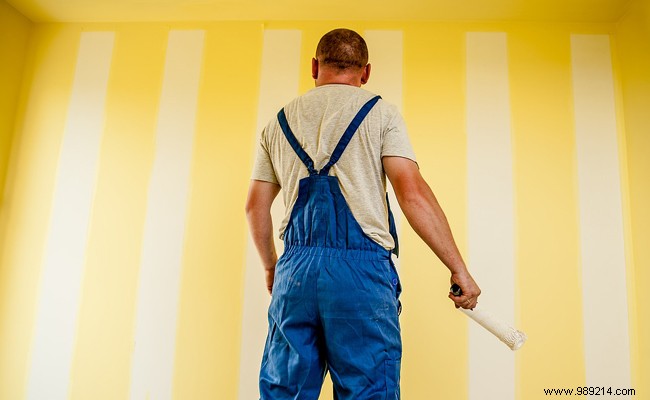
Do you want to undertake painting work in your home? It is not always easy to know how to go about it, or whether to call a professional. Here are some tips to guide you better.
Many private individuals embark on their painting work, for pleasure or for financial reasons. This is the most common work done in homes. If they are generally rather simple to carry out, it is advisable not to launch without preparation and without knowing some useful tips and advice.
Make sure you choose the right paint color, one that will not tire you and that will enhance your interior. In addition to the choice of shade, it is necessary to define the type of paint, because not all of them are suitable for all uses. Acrylic is not weather resistant and should only be used indoors. On the contrary, glycero is suitable for exterior facades and garden furniture. Finally, choose the right look, i.e. glossy, matte or satin, depending on the desired finishes.
To avoid running out of paint or ending up with full or barely started pots, it is advisable to carefully assess the quantities needed. Get advice from a salesperson and beware of monolayers, most of which are not really monolayers to obtain an optimal result.
The slightest stain of paint can be problematic. If possible, empty the room of its furniture or protect the furniture and all surfaces that are not to be painted.
Prepare your walls well before painting them, you will avoid surface defects and the color will last much longer without being damaged. Remove old paint, upholstery or miscellaneous residue. Wash the entire surface of the wall to remove dirt and traces of grease. Finally, fill the cracks and holes and sand the surface roughness.
For quality work and optimal rendering, it is essential to invest in quality equipment. Get advice from professionals and avoid first-price tools. You would then have a good chance of ending up with a brush that loses its bristles, a roller that comes apart or does not turn, or a protective tape that lets paint through.
Do not always rely on the colors on the lids of the paint cans, the rendering can be completely different once on your walls. Coat a white cardboard 50 cm side with two coats of paint and place it in different places of the room to be painted. Observe how the hue takes in the light, what it renders at different times of the day, and how well it matches your furnishings. You will avoid the risk of bad surprises!
Properly preparing your wall with an undercoat is essential for the durability of your paintwork. It helps it to adhere better to the support and requires fewer coats of paint on the surface to obtain an optimal and uniform result. There are undercoats for all surfaces that can be painted.
Don't start at the center of the wall; as it dries, the paint would leave streaks that are difficult to hide. Delineate the surfaces to be painted with removable tape and start with the corners and edges, making strips about 10 cm wide. Then progress to the right or to the left in small areas, using a horizontal application with paint and a vertical application without adding paint to smooth the surface.
Do not abuse the quantities, but do not be too light handed either. Too much paint creates drips and irregularities on the surface; too little material will leave marks that will dry too quickly to be smoothed. Mix the paint well in the jar, half-dip the roller in it and remove the excess using the screen.
Don't limit yourself to one layer. The wall absorbs the first and does not allow to obtain a smooth and optimal rendering. To perfect the result of the undercoat and the first coat, it is strongly recommended to apply a second, then a third, or even more.
If you want to entrust your painting work to a professional, it's simple! Make quotes to select the right painter at a price that suits you. Make sure that the one you choose is a quality craftsman, who will be able to carry out impeccable work for you. If the task is simple, the preparation time is essential and represents the greatest part of the work. A poorly prepared wall will be poorly painted. Thus, the professional takes more time to prepare the support than to apply the coats of paint, which can explain the sometimes high labor costs.
The painter prepares the site by protecting all the surfaces and any furniture present. It cleans the walls and fills in the holes and cracks. He can, if necessary, apply a specific undercoat, to treat humidity for example. Once the wall is ready, he applies the paint in several layers.
The costs of your work depend on many different parameters. If you do your work yourself, it will only cost you the purchase of materials and paint.
If you are hiring a professional, get quotes online. Some craftsmen apply an hourly rate by estimating the duration of work necessary to carry out your work. Others are based on an estimate of the surface to be painted (in m²) to establish their estimate. The price includes labor, the cost of material and paint.
Count on average between 20 and 30 euros per m². The price can change according to different variables:
For the realization of your painting work, you can benefit from several aids and subsidies.